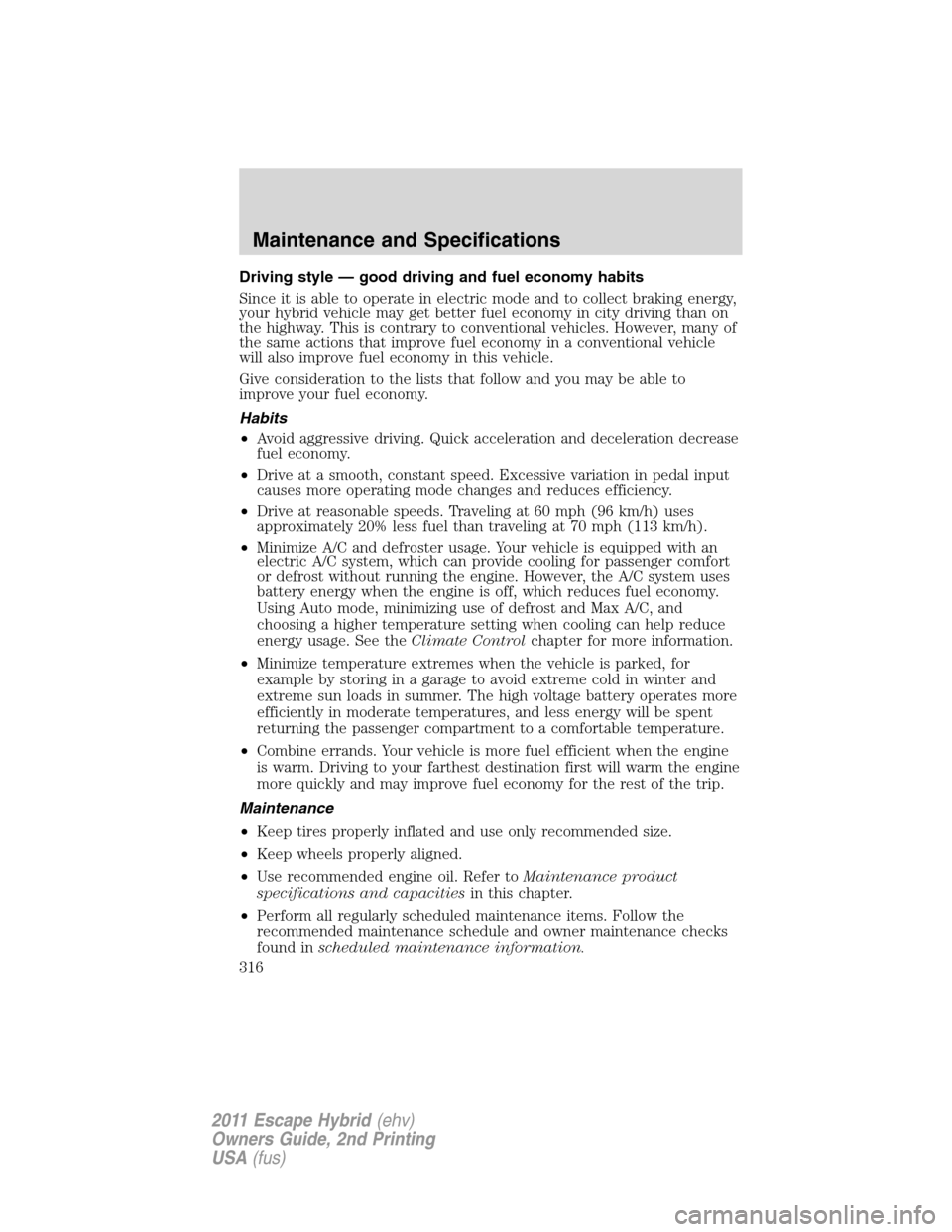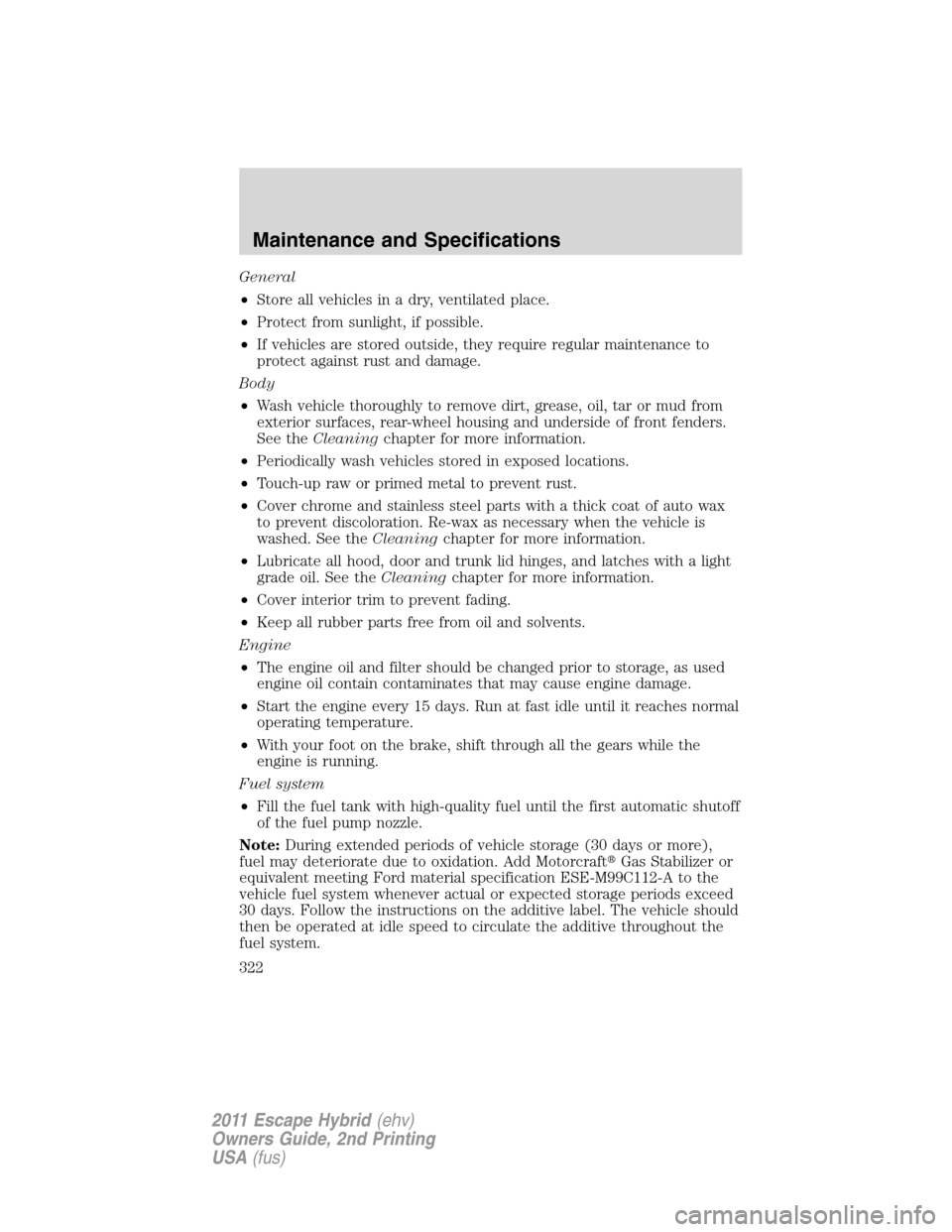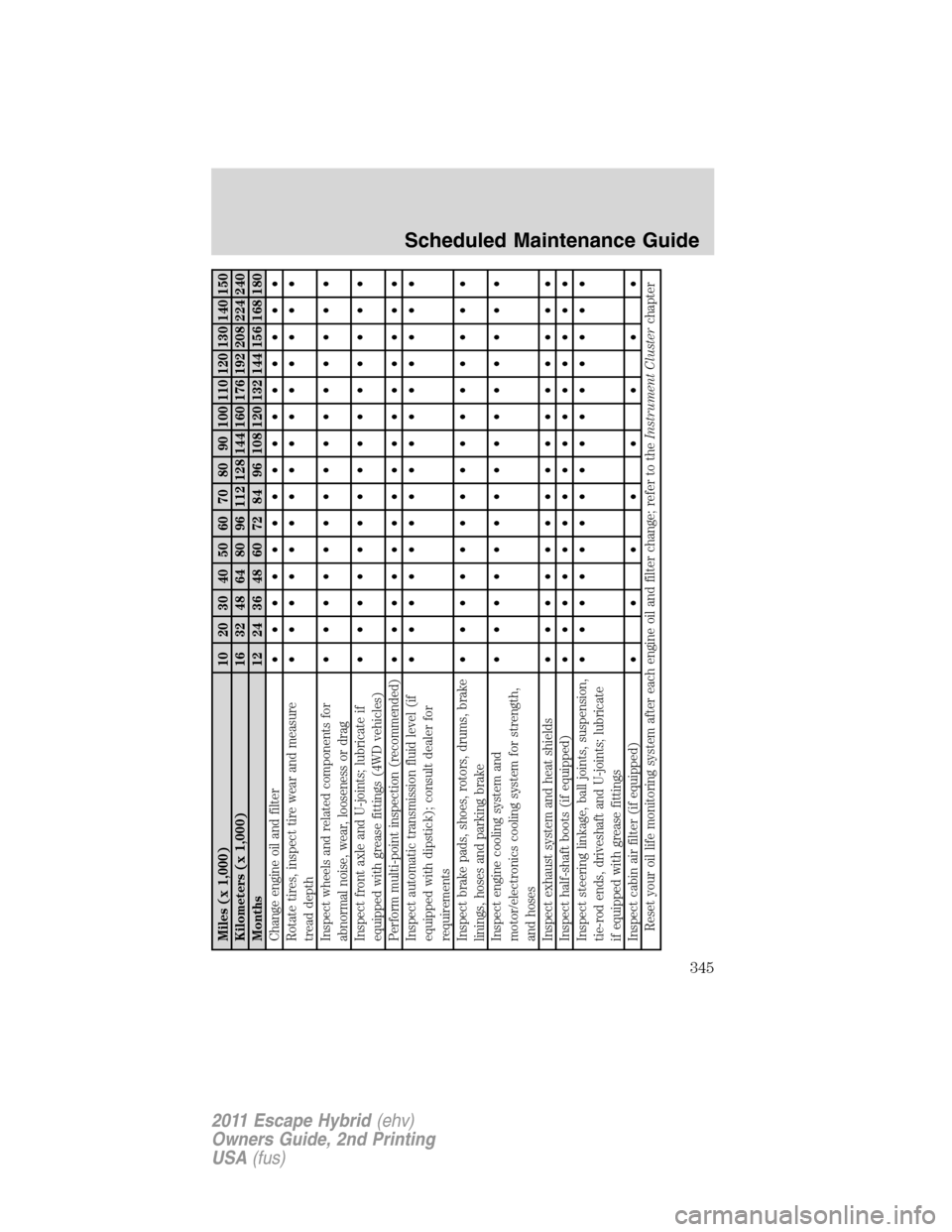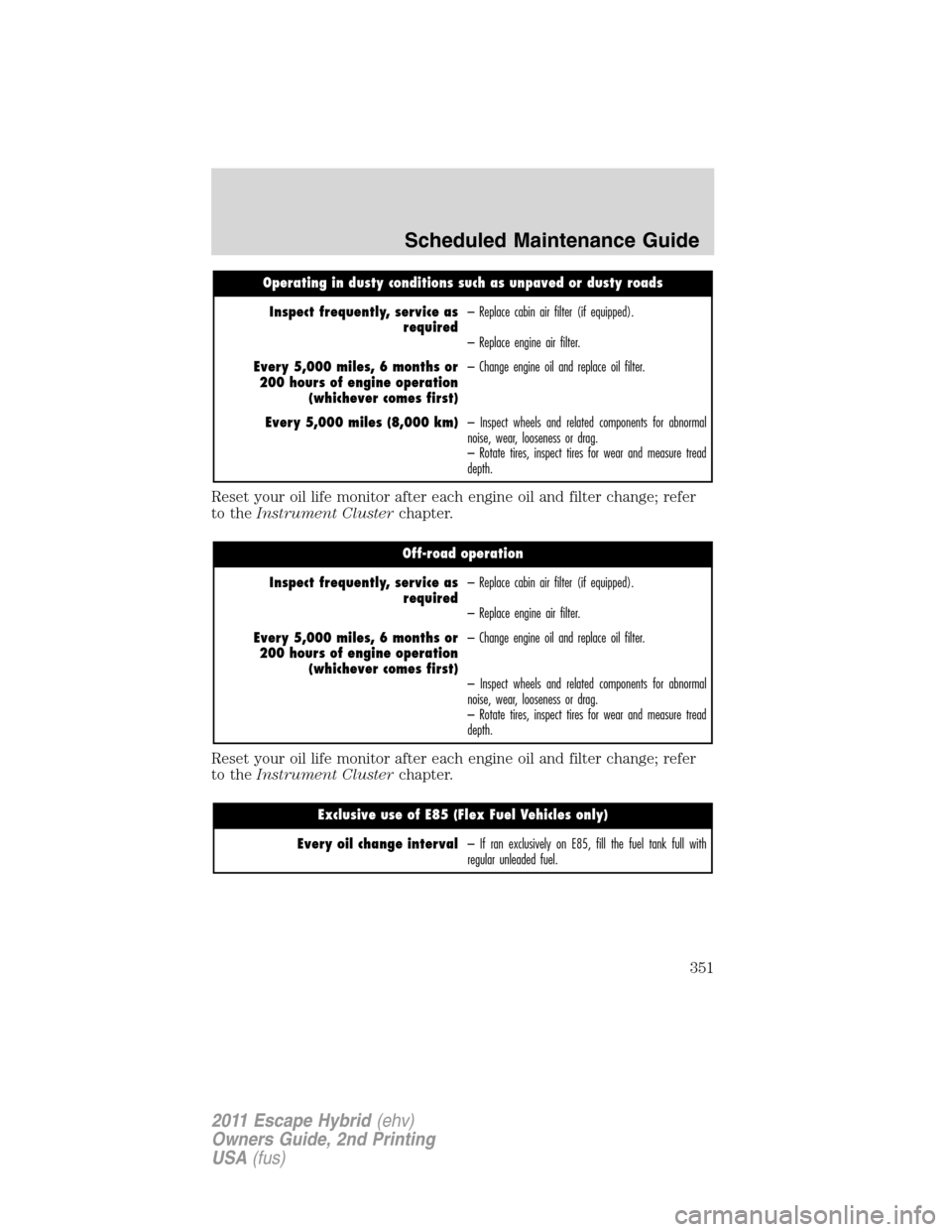Page 316 of 363

Driving style — good driving and fuel economy habits
Since it is able to operate in electric mode and to collect braking energy,
your hybrid vehicle may get better fuel economy in city driving than on
the highway. This is contrary to conventional vehicles. However, many of
the same actions that improve fuel economy in a conventional vehicle
will also improve fuel economy in this vehicle.
Give consideration to the lists that follow and you may be able to
improve your fuel economy.
Habits
•Avoid aggressive driving. Quick acceleration and deceleration decrease
fuel economy.
•Drive at a smooth, constant speed. Excessive variation in pedal input
causes more operating mode changes and reduces efficiency.
•Drive at reasonable speeds. Traveling at 60 mph (96 km/h) uses
approximately 20% less fuel than traveling at 70 mph (113 km/h).
•Minimize A/C and defroster usage. Your vehicle is equipped with an
electric A/C system, which can provide cooling for passenger comfort
or defrost without running the engine. However, the A/C system uses
battery energy when the engine is off, which reduces fuel economy.
Using Auto mode, minimizing use of defrost and Max A/C, and
choosing a higher temperature setting when cooling can help reduce
energy usage. See theClimate Controlchapter for more information.
•Minimize temperature extremes when the vehicle is parked, for
example by storing in a garage to avoid extreme cold in winter and
extreme sun loads in summer. The high voltage battery operates more
efficiently in moderate temperatures, and less energy will be spent
returning the passenger compartment to a comfortable temperature.
•Combine errands. Your vehicle is more fuel efficient when the engine
is warm. Driving to your farthest destination first will warm the engine
more quickly and may improve fuel economy for the rest of the trip.
Maintenance
•Keep tires properly inflated and use only recommended size.
•Keep wheels properly aligned.
•Use recommended engine oil. Refer toMaintenance product
specifications and capacitiesin this chapter.
•Perform all regularly scheduled maintenance items. Follow the
recommended maintenance schedule and owner maintenance checks
found inscheduled maintenance information.
Maintenance and Specifications
316
2011 Escape Hybrid(ehv)
Owners Guide, 2nd Printing
USA(fus)
Page 322 of 363

General
•Store all vehicles in a dry, ventilated place.
•Protect from sunlight, if possible.
•If vehicles are stored outside, they require regular maintenance to
protect against rust and damage.
Body
•Wash vehicle thoroughly to remove dirt, grease, oil, tar or mud from
exterior surfaces, rear-wheel housing and underside of front fenders.
See theCleaningchapter for more information.
•Periodically wash vehicles stored in exposed locations.
•Touch-up raw or primed metal to prevent rust.
•Cover chrome and stainless steel parts with a thick coat of auto wax
to prevent discoloration. Re-wax as necessary when the vehicle is
washed. See theCleaningchapter for more information.
•Lubricate all hood, door and trunk lid hinges, and latches with a light
grade oil. See theCleaningchapter for more information.
•Cover interior trim to prevent fading.
•Keep all rubber parts free from oil and solvents.
Engine
•The engine oil and filter should be changed prior to storage, as used
engine oil contain contaminates that may cause engine damage.
•Start the engine every 15 days. Run at fast idle until it reaches normal
operating temperature.
•With your foot on the brake, shift through all the gears while the
engine is running.
Fuel system
•Fill the fuel tank with high-quality fuel until the first automatic shutoff
of the fuel pump nozzle.
Note:During extended periods of vehicle storage (30 days or more),
fuel may deteriorate due to oxidation. Add Motorcraft�Gas Stabilizer or
equivalent meeting Ford material specification ESE-M99C112-A to the
vehicle fuel system whenever actual or expected storage periods exceed
30 days. Follow the instructions on the additive label. The vehicle should
then be operated at idle speed to circulate the additive throughout the
fuel system.
Maintenance and Specifications
322
2011 Escape Hybrid(ehv)
Owners Guide, 2nd Printing
USA(fus)
Page 345 of 363

Miles (x 1,000) 10 20 30 40 50 60 70 80 90 100 110 120 130 140 150
Kilometers (x 1,000) 16 32 48 64 80 96 112 128 144 160 176 192 208 224 240
Months 12 24 36 48 60 72 84 96 108 120 132 144 156 168 180
Change engine oil and filter• ••••••••••••••
Rotate tires, inspect tire wear and measure
tread depth• ••••••••••••••
Inspect wheels and related components for
abnormal noise, wear, looseness or drag• ••••••••••••••
Inspect front axle and U-joints; lubricate if
equipped with grease fittings (4WD vehicles)• ••••••••••••••
Perform multi-point inspection (recommended)• ••••••••••••••
Inspect automatic transmission fluid level (if
equipped with dipstick); consult dealer for
requirements• ••••••••••••••
Inspect brake pads, shoes, rotors, drums, brake
linings, hoses and parking brake• ••••••••••••••
Inspect engine cooling system and
motor/electronics cooling system for strength,
and hoses• ••••••••••••••
Inspect exhaust system and heat shields• ••••••••••••••
Inspect half-shaft boots (if equipped)• ••••••••••••••
Inspect steering linkage, ball joints, suspension,
tie-rod ends, driveshaft and U-joints; lubricate
if equipped with grease fittings• ••••••••••••••
Inspect cabin air filter (if equipped)• •••••••
Reset your oil life monitoring system after each engine oil and filter change; refer to theInstrument Clusterchapter
Scheduled Maintenance Guide
345
2011 Escape Hybrid(ehv)
Owners Guide, 2nd Printing
USA(fus)
Page 350 of 363

SPECIAL OPERATING CONDITIONS
If you operate your Ford/Lincoln/Mercury vehicleprimarilyin one of the
more demandingSpecial Operating Conditionslisted below, you will
need to have some items maintained more frequently. If you only
occasionallyoperate your vehicle under these conditions, it is not
necessary to perform the additional maintenance. For specific
recommendations, see your Ford or Lincoln Mercury dealership service
advisor or technician.
Towing a trailer or using a camper or car-top carrier
Every 5,000 miles, 6 months or
200 hours of engine operation
(whichever comes first)– Change engine oil and replace oil filter
Every 5,000 miles (8,000 km)– Inspect wheels and related components for abnormal
noise, wear, looseness or drag.
– Rotate tires, inspect tires for wear and measure tread
depth.
Extensive idling and/or low speed driving for long distances as in heavy
commercial use such as delivery, taxi, patrol vehicle or livery. This
operating condition is for extensive maximum A/C or heater operation
with engine on in the above listed usage.
Inspect frequently, service as
required– Replace cabin air filter (if equipped).
Every 5,000 miles, 6 months or
200 hours of engine operation
(whichever comes first)– Change engine oil and replace oil filter
Every 5,000 miles (8,000 km)– Inspect wheels and related components for abnormal
noise, wear, looseness or drag.
– Rotate tires, inspect tires for wear and measure tread
depth.
Every 60,000 miles (96,000 km)– Replace spark plugs.
Scheduled Maintenance Guide
350
2011 Escape Hybrid(ehv)
Owners Guide, 2nd Printing
USA(fus)
Page 351 of 363

Operating in dusty conditions such as unpaved or dusty roads
Inspect frequently, service as
required– Replace cabin air filter (if equipped).
– Replace engine air filter.
Every 5,000 miles, 6 months or
200 hours of engine operation
(whichever comes first)– Change engine oil and replace oil filter.
Every 5,000 miles (8,000 km)– Inspect wheels and related components for abnormal
noise, wear, looseness or drag.
– Rotate tires, inspect tires for wear and measure tread
depth.
Reset your oil life monitor after each engine oil and filter change; refer
to theInstrument Clusterchapter.
Off-road operation
Inspect frequently, service as
required– Replace cabin air filter (if equipped).
– Replace engine air filter.
Every 5,000 miles, 6 months or
200 hours of engine operation
(whichever comes first)– Change engine oil and replace oil filter.
– Inspect wheels and related components for abnormal
noise, wear, looseness or drag.
– Rotate tires, inspect tires for wear and measure tread
depth.
Reset your oil life monitor after each engine oil and filter change; refer
to theInstrument Clusterchapter.
Exclusive use of E85 (Flex Fuel Vehicles only)
Every oil change interval– If ran exclusively on E85, fill the fuel tank full with
regular unleaded fuel.
Scheduled Maintenance Guide
351
2011 Escape Hybrid(ehv)
Owners Guide, 2nd Printing
USA(fus)
Page:
< prev 1-8 9-16 17-24